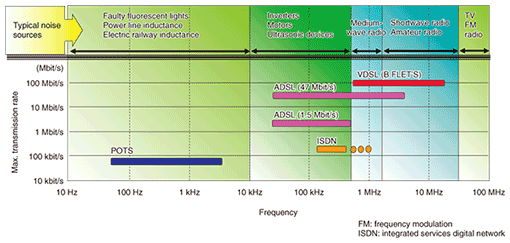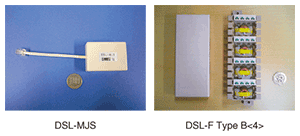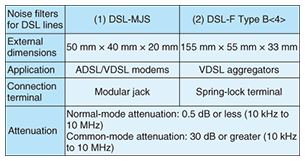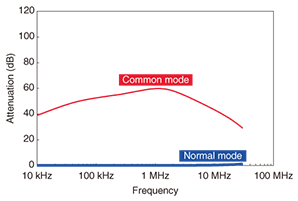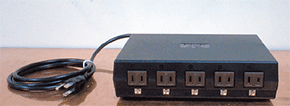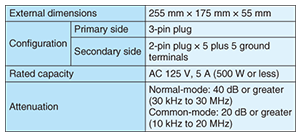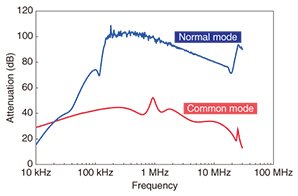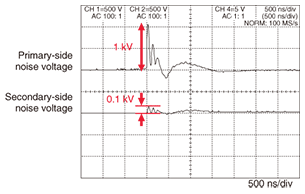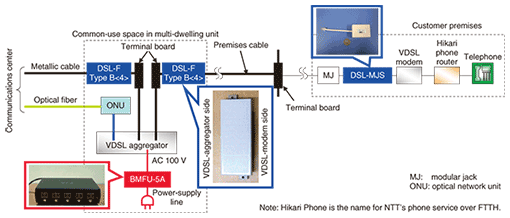 |
|||||
|
|
|||||
|
Practical Field Information about Telecommunication Technologies Vol. 9, No. 4, pp. 69–73, Apr. 2011. https://doi.org/10.53829/ntr201104pf1 EMC Countermeasure Products for DSL ServicesAbstractThis article introduces EMC countermeasure products for overcoming electromagnetic compatibility problems in digital subscriber line (DSL) services, i.e., noise filters, which have been developed by NTT EAST. It is the fourth in a bimonthly series on the theme of practical field information about telecommunication technologies. This month’s contribution is from the EMC Engineering Group, Technical Assistance and Support Center, Maintenance and Service Operations Department, Network Business Headquarters.
1. IntroductionBroadband services typified by digital subscriber line (DSL) and fiber to the home (FTTH) have been spreading rapidly. Among DSL services, very-high-bitrate DSL (VDSL) has been widely used as a means of providing FTTH services to individual user premises in multi-dwelling units like apartment complexes or dormitories. However, users’ homes often contain inverter noise generated by home electronics, fluorescent lights, and other devices as well as electromagnetic noise from broadcast signals, amateur radio, and other sources. In short, the electromagnetic environment in the home has become increasingly bad, and electromagnetic noise may affect DSL communication signals, so undesirable phenomena such as drops in transmission speed and lost links may occur. To solve this problem of electromagnetic noise that affects DSL services, the EMC Engineering Group has developed noise filters for use with DSL. This article introduces these products. 2. Environments surrounding broadband services2.1 Transmission signals and noise over a wide bandTransmission frequency bands for VDSL, asynchronous DSL (ADSL), other services, and typical sources of electromagnetic noise are shown in Fig. 1. The transmission band of POTS (plain old telephone service; the standard telephone service) is an audible band covering the frequencies of the human voice. For this band, typical types of electromagnetic noise are low-frequency noise from fluorescent lights and electromagnetic induction noise from power lines and electric railways. In contrast, ADSL and VDSL use a wide band from about 20 kHz to 30 MHz, in which a variety of electromagnetic-noise sources are known to exist such as inverters, motors, ultrasonic devices, medium-wave and shortwave radio, and amateur radio. Thus, broadband signals may be affected by electromagnetic disturbances generated from a variety of electromagnetic noise sources.
2.2 Installation environmentsThe number of sites installing telecommunication equipment to get broadband services is increasing. These include not only general households but also office buildings. Since telecommunication equipment connects to power systems just like electronic devices, low-frequency noise from inverters and impulsive (high-frequency) noise generated by on/off switching of power supplies can enter telecommunication equipment through power lines. This can cause undesirable phenomenon like transmission speed drops and lost links. Furthermore, it is not uncommon in some types of installation environments for telecommunication equipment to be installed without ground connections even though the equipment itself may include ground terminals. The roles of a ground are to protect the human body, secure a reference potential, and improve the balance between a communications device and the earth’s surface. But in actual environments, there are many situations in which ground connections cannot be performed, and inserting noise filters in such a situation has been found to have no effect. There is therefore a need for strong electromagnetic compatibility (EMC) effects (noise countermeasures) even in environments in which ground connections cannot be performed. 3. EMC countermeasures for DSL services3.1 EMC problemsA number of EMC-related problems need to be solved to improve the reliability and convenience of DSL services, and to this end, the following technologies are needed. (1) Noise-filtering technology for communication lines causing little attenuation (insertion loss) of transmission signals (normal mode) while having a large electromagnetic-noise (common mode) suppression effect (2) Noise-filtering technology for wideband power-supply systems targeting both low-frequency noise from inverter equipment and other devices and impulsive noise generated by on/off switching of power supplies (3) Noise-filtering technology that can achieve a strong noise-suppression effect even in installation sites where grounding cannot be performed To satisfy these three technology requirements, NTT EAST has developed noise filters for DSL lines (DSL-MJS and DSL-F Type B<4>) and a power-supply tap with a built-in noise filter (BMFU-5A). These products are described below. 3.2 EMC countermeasures for communication lines (noise filters for DSL lines)The noise filters for DSL lines developed by NTT EAST come in two types: DSL-MJS for DSL modems connects by a modular jack and DSL-F Type B<4> for VDSL aggregators connects by spring-lock terminals. The appearances of these filters are shown in Fig. 2 and their features are listed in Table 1. Owing to the difference in the way that these filters connect, the DSL-MJS filter is effective against noise for ADSL/VDSL modems while the DSL-F Type B<4> filter is effective for VDSL aggregators. The common- and normal-mode attenuation characteristics of these noise filters for DSL lines are shown in Fig. 3. These filters are of the toroidal* type that uses core materials with high magnetic permeability. In the frequency range from 10 kHz to 10 MHz, they achieve common-mode attenuation of 30 dB or more and suppress normal-mode attenuation to less than 0.5 dB. These filters therefore provide more effective EMC countermeasures for DSL services than existing ones.
3.3 EMC countermeasure for power-supply lines (power-supply tap with built-in noise filter)The appearance of the power-supply tap with built-in noise filter (BMFU-5A) developed by NTT EAST is shown in Fig. 4. This product has a three-pin plug on the primary side and provides five 2-pin sockets, each with a ground terminal, on the secondary side. Its features are listed in Table 2. Compared with a noise-cutoff transformer with the same rated capacity, this equipment is compact and light, which makes it suitable for installation in tight spaces like a main distribution frame (MDF) room housing a VDSL aggregator in a multi-dwelling unit. The common- and normal-mode attenuation characteristics of this power-supply tap with built-in noise filter are shown in Fig. 5. They show that common-mode attenuation in a state with no ground connection is high—20 dB or greater in the frequency range from 10 kHz to 20 MHz—and that normal-mode attenuation is also high: 40 dB in the frequency range from 30 kHz to 30 MHz. This product is therefore effective against noise over a wide band including inverter noise and impulsive noise caused by on/off switching. Its normal-mode attenuation is higher than that of noise filters for DSL lines, but since the amount of attenuation at a frequency of 50/60 Hz in AC power supplies is small enough to be ignored, there is no effect on the AC feed. As described above, the product has a noise-suppression effect of 20 dB or greater in situations with no ground connection, but an even greater noise-suppression effect can be obtained if the ground terminal is connected to the building or another ground.
For reference purposes, Fig. 6 shows the results of measuring the noise-suppression effect of this product when a 1-kV impulse wave was applied to the power-supply line as specified in the fast transient/burst test at an AC power-supply port in NTT’s technical requirements (TR549001). These results show that a burst impulse of 1 kV is attenuated to 1/10 or less on the secondary side, which indicates that this product also has a sufficient noise-suppression effect on impulsive noise.
4. Example of EMC countermeasures for VDSL servicesAn example of implementing EMC countermeasures for VDSL services provided for a multi-dwelling unit is shown in Fig. 7. In this scenario, metallic cable and optical fiber from a communications center connect to a VDSL aggregator in the building’s common-use space, and the VDSL aggregator connects to the VDSL modem inside the customer’s premises via metallic cable inside the building.
The places where electromagnetic noise can enter telecommunication equipment are mainly power-supply lines and communication lines. Electromagnetic noise can also propagate via metallic cables inside the building. The filters introduced in this article are used at these locations. The setup in Fig. 7 shows how a BMFU-5A filter can be used as an EMC countermeasure on the power-supply line of a VDSL aggregator. Moreover, DSL-F Type B<4> filters can be used as an EMC countermeasure on communication lines while a DSL-MJS filter can be used on the communication-line port of the VDSL modem. Using filters in this way at locations where noise can enter can mitigate the effects of noise on telecommunication equipment. 5. ConclusionThis article introduced noise filters for DSL lines and a power-supply tap with a built-in noise filter as EMC countermeasure products for DSL services. Looking forward, the Technical Assistance and Support Center at NTT EAST will continue its work on solving noise problems with the aim of providing NTT customers with stable broadband services. |
|||||








